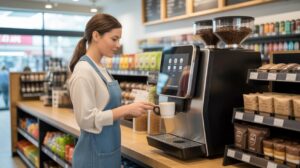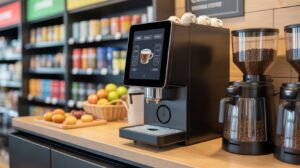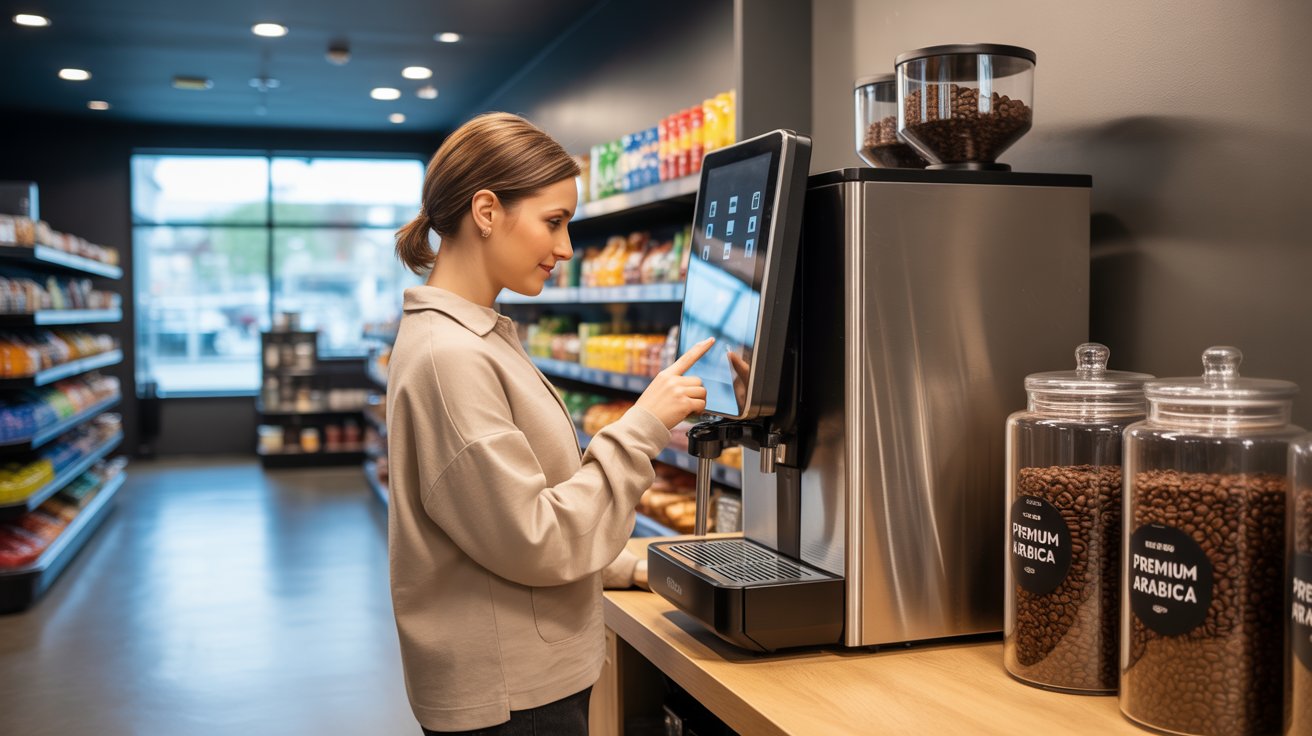Tired of stale, burnt-tasting coffee in your store?
In This Article
ToggleToday’s customers expect more — and they’re willing to pay for it.
That’s why the bean to cup coffee machine convenience store trend is taking over. It’s not just a better cup of coffee — it’s a smarter business move.
These machines grind fresh beans on demand, brew with precision, and deliver barista-quality coffee in seconds. No staff needed. No waste. No guesswork.
For store owners, that means higher margins, fewer headaches, and a better customer experience that keeps people coming back.
In this guide, you’ll learn exactly how bean-to-cup systems are reshaping retail coffee — and how your store can profit from it.
Why Convenience Stores Are Switching to Bean‑to‑Cup Systems
Bean‑to‑cup machines aren’t just a new tech trend — they’re transforming how convenience stores deliver coffee. Here’s why more retailers are making the switch:
Superior Coffee Quality and Freshness
Let’s be real — customers know the difference between fresh and stale coffee.
With bean-to-cup machines, every cup starts with freshly ground beans, brewed on demand. No burnt carafes. No hour-old drip pots.
The result?
Barista-level quality in under 60 seconds
Consistent taste across all store locations
A noticeable upgrade customers rave about
According to NACs Magazine and CStoreDecisions.com, brands like Dash In and Circle K report huge gains in guest satisfaction and repeat visits after upgrading to bean-to-cup.
Operational Efficiency and Labor Savings
Staffing issues? Bean-to-cup has your back.
These machines are fully automated, meaning:
No brewing required by staff
No training needed for complex equipment
Customers serve themselves with a simple touchscreen
As NACs Magazine reports, retailers are saving on labor without compromising on quality. Fewer tasks, fewer mistakes, more uptime.
Waste Minimization and Cost Control
Wasted coffee = wasted money.
Traditional drip machines often mean dumping unused pots or guessing at demand. Bean-to-cup systems only brew what’s ordered, ensuring:
Precision dispensing down to the gram
Minimal grounds waste
Better inventory tracking and reduced shrink
Over time, that adds up to significant savings — especially for high-volume stores.
Real‑World Adoption: Case Studies in C‑Store Chains

Don’t just take our word for it. Top chains are proving the value of bean-to-cup machines daily.
Circle K: Touchscreen Coffee Kiosks & Customization Features
Circle K rolled out touchscreen bean-to-cup systems across the U.S., letting customers customize every cup.
The result?
Higher engagement through interactivity
Boosted sales from specialty drink upgrades
Seamless integration with loyalty apps and promotions
(Axios)
Sheetz and Dash In: Satisfaction Up, Waste Near Zero
Sheetz upgraded to Franke A800 bean-to-cup machines, offering flavor variety and consistent taste. Dash In saw similar success with self-serve espresso units.
Benefits reported:
Near-zero waste with per-cup brewing
Improved perception of store quality
Customers willingly paying more per cup
(ConcordiaCoffee.com, NACs Magazine)
Kwik Trip: Self‑Serve Espresso Since 2014
Kwik Trip implemented self‑serve latte and espresso machines over a decade ago — and it’s still paying off.
According to People.com and Axios:
Kwik Trip customers regularly cite coffee quality as a key reason they return
The system handles volume without staff intervention
Kwik Trip has built an in-store coffee brand identity using this model
Bottom Line:
Bean-to-cup machines aren’t just better for your customers — they’re better for your business.
Next, we’ll show you exactly how these machines work inside a c-store environment… and how to choose the right one for your store.
How Bean‑to‑Cup Machines Work in Convenience Store Environments
Bean‑to‑cup machines are super‑automatic coffee systems built for speed, consistency, and minimal human input. Here’s how they function in real-world convenience store environments:
Grinding, Tamping, Brewing & Steaming: Fully Automated Sequence
(Sources: techradar.com, info.craftydelivers.com, cafedumonde.co.uk)
The magic starts the moment a customer makes a selection. Here’s what happens behind the scenes:
Fresh whole beans are ground on demand for every order — no pre-ground waste.
The machine automatically tamps the grounds with optimal pressure.
Hot water is forced through the grounds under high pressure, producing rich espresso or coffee.
For lattes or cappuccinos, the machine steams or froths milk — either fresh or powdered — to match the recipe.
It’s a barista-level process, minus the barista.
No special training needed. No guesswork. No waiting.
Interface & Customization Options
(Sources: Ideal Home, United Fast Food, cafedumonde.co.uk)
Today’s machines aren’t just smart — they’re interactive.
Customers can use touchscreen interfaces to tailor their drinks, including:
Coffee strength
Roast level
Cup size
Milk quantity and froth level
Sugar and syrup preferences
This level of customization gives customers control — and gives stores a premium experience without premium staffing.
Bonus: Some systems integrate with loyalty apps, so customers can save favorite drinks for faster reorders.
Maintenance Workflows & Cleaning Schedules
(Sources: NACs Magazine, info.craftydelivers.com)
Easy upkeep is essential in busy retail environments.
Thankfully, bean-to-cup machines are designed with automated maintenance cycles to keep things clean and compliant.
Here’s the typical daily routine:
Daily rinse cycles flush out brew chambers automatically
Hopper refills (beans, milk, water) are simple and fast
Weekly descaling and deep cleaning are guided by machine alerts
Most brands include on-screen instructions for every step — no manuals needed. That means less downtime, and no specialized techs for routine care.
Choosing the Right Machine for Your Convenience Store

Not all bean-to-cup systems are created equal. Choosing the right one comes down to matching machine specs with store needs.
Capacity & Throughput Needs
Ask yourself:
How many cups per day does your location serve?
Will it need to handle back-to-back orders during rushes?
High-traffic stores should choose machines with:
Large bean and water hoppers
Fast recovery times between drinks
Output of 80–200 cups per day minimum
This ensures customers aren’t waiting — and your staff isn’t constantly refilling supplies.
Feature Comparison: Touchscreen vs. Basic Interface | Fresh Milk vs. Powdered
Touchscreen interfaces offer:
More intuitive customer experience
Visual drink customization
Integration with loyalty programs
Basic interfaces (buttons/LED) may be better for smaller stores with fixed drink menus.
Fresh milk systems deliver superior taste but require refrigeration and stricter cleaning.
Powdered milk models are easier to maintain — great for stores with limited staff or no refrigeration.
Choose based on your staff capacity and customer expectations.
Brand Spotlight: Best Machines for C-Stores
(Sources: techradar.com, info.craftydelivers.com, concordiacoffee.com, nestleprofessional.us, United Fast Food)
Here are top commercial-grade bean-to-cup machines trusted by convenience chains:
Schaerer Coffee Soul / Barista – Touchscreen, high capacity, fresh milk compatibility
Wilbur Curtis Genesis – Fast-brew, compact footprint, reliable for high-volume traffic
Concordia Ascent Touch / Xpress Touch – All-in-one systems with user-friendly design and IoT telemetry
Nestlé Milano / Nescafé Alegria – Cost-effective, powdered-milk systems for low-maintenance use
Each brand offers different strengths depending on store volume, layout, and drink options.
Need help deciding? We’ll cover ROI and financial comparisons next.
Financial & ROI Analysis
Investing in a bean-to-cup machine isn’t just about better coffee — it’s about better profit.
Break‑Even Calculation: Machine Cost vs. Labor & Waste Savings
Let’s run the numbers.
Example scenario:
Commercial bean-to-cup machine: $7,000–$12,000 upfront
Average c-store drip coffee waste: 30–40% daily
Labor costs to manage coffee station: $2,000+/month per location
With bean-to-cup:
Labor shrinks — no brewing, no dumping, no cleanup
Waste drops — coffee brewed per cup, not by the pot
Break-even point: 6–12 months, depending on volume and labor savings
After that, it’s nearly pure profit.
Beverage Margin Uplift Over Drip Coffee
The numbers speak for themselves:
Average drip coffee margin: ~55%
Bean-to-cup coffee margin: 70–75%
Higher margins come from:
Premium pricing ($1.89–$2.79 vs. $0.99–$1.29)
Less product loss
Lower per-cup labor cost
Customers perceive more value, and they’re happy to pay for it.
Cost Model: Beans, Maintenance, and Service Contracts
Plan your budget with precision. Here’s what to expect:
| Cost Component | Typical Range |
|---|---|
| Beans (per lb) | $6–$12 (100–120 cups/lb) |
| Milk (fresh or powder) | $0.05–$0.15 per cup |
| Cleaning supplies | $20–$50/month |
| Service contract | $500–$1,200/year (optional but smart) |
Tip: Choose a machine with telemetry or IoT monitoring to detect issues early and reduce downtime.
Launch & Operational Best Practices
Rolling out a bean-to-cup program? Follow these steps to maximize impact from day one.
Staff & Customer Training Tips
(Sources: United Fast Food, NACs Magazine)
Switching from a traditional pot to a self-serve system? Keep it simple.
Train staff in 15 minutes using manufacturer videos or step-by-step demos
Show how to refill hoppers, run cleaning cycles, and troubleshoot basic alerts
Teach customers with on-screen guidance, clear signage, or short videos at the station
Pro tip: Empower staff to treat the machine like a money-maker — not just another appliance.
Flavor Rotation & Seasonal Promotions
Keep your offerings fresh — literally.
Popular promotional flavors include:
Vermont Maple Nut
Colombian Dark Roast
Pumpkin Spice (fall)
Peppermint Mocha (winter)
Why it works:
Increases repeat visits
Creates limited-time urgency
Differentiates your store from chains
Rotate new flavors monthly or quarterly, and display them front and center.
In‑Store Signage & Marketing Tactics
Don’t just install a machine — market it like a product.
Use these high-converting tactics:
Point-of-sale prompts at the register
Window clings promoting “Fresh, barista-style coffee inside”
Aroma stations near the entrance to attract foot traffic
Loyalty card integration or “Buy 5, get 1 free” punch cards
Bonus: Place the machine where customers see, smell, and walk by it often — visibility = conversions.
Conclusion
Bean-to-cup coffee machines are more than an upgrade — they’re a competitive advantage for convenience stores.
They deliver:
Fresher, higher-quality coffee
Streamlined operations and staffing
Stronger profit margins and ROI
FAQs & Troubleshooting
What is a bean‑to‑cup coffee machine convenience store setup?
It’s a self-serve coffee system that grinds whole beans fresh for every cup, typically installed in convenience stores.
Customers select their drink via touchscreen, and the machine automatically grinds, brews, and froths — no staff required.
Perfect for high-volume retail, it delivers barista-quality coffee with minimal labor or waste.
How much does a c‑store bean‑to‑cup system cost?
Costs vary depending on machine specs, but here’s a typical range:
Entry-level (low volume): $4,000–$6,000
Mid-tier (moderate volume): $7,000–$10,000
High-end (high throughput, advanced features): $12,000–$18,000
Factor in ongoing costs for beans, cleaning supplies, and optional service contracts. Most stores break even in 6–12 months.
How do you clean and maintain a bean‑to‑cup kiosk?
Most systems are automated for daily rinse cycles and prompt you when deeper cleaning is needed.
Daily tasks:
Empty waste bin
Rinse brew unit
Refill beans and milk
Weekly:
Descale
Run full cleaning cycle
Top machines include on-screen instructions, making upkeep fast and staff-friendly.
Can convenience stores customize drinks per location?
Yes — absolutely.
Most modern machines allow admin-level programming to:
Adjust available drink options
Modify strength, temperature, and froth levels
Enable or disable seasonal flavors
This means each store can align offerings to local tastes or traffic, giving you full control across locations.

Mahian has an insatiable curiosity for discovering unique coffee beans and exploring global café trends. He delves into the stories of coffee origins, packaging innovations, and the evolving landscape of café culture. Mahian’s contributions provide readers with a broader perspective on the world of coffee.

